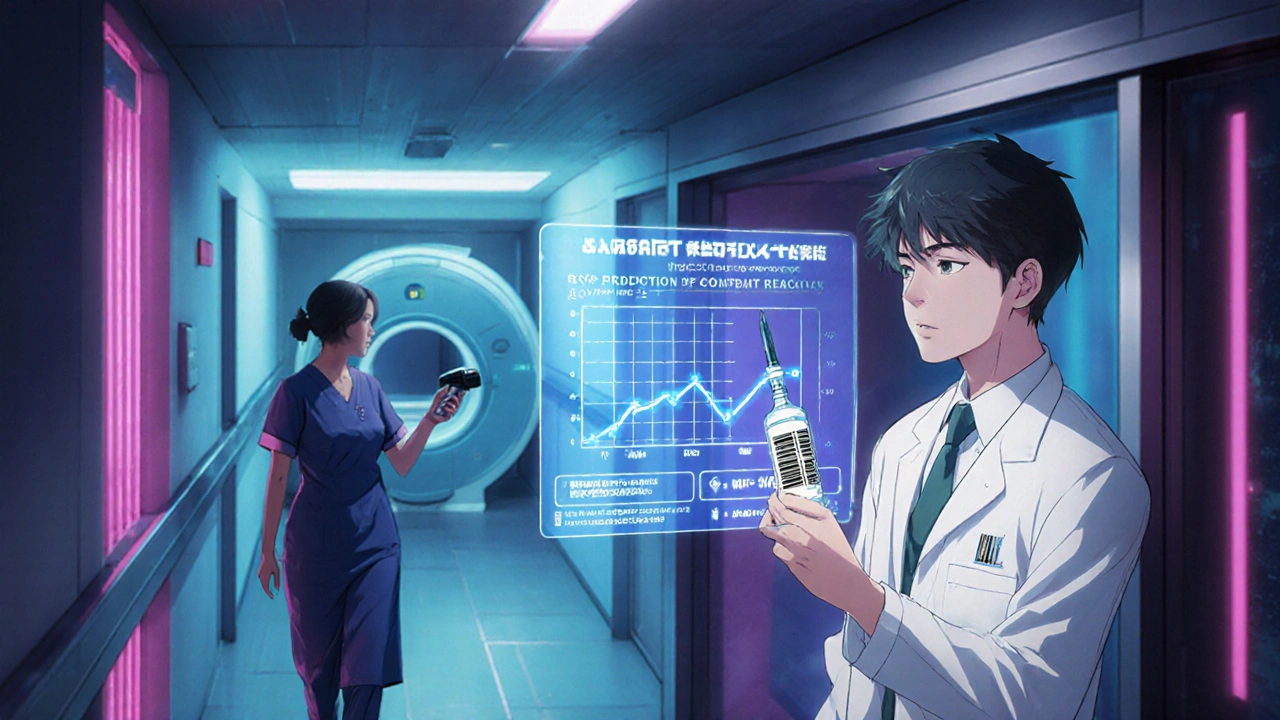Pre‑Medication Strategies: Antiemetics, Antihistamines & Steroids Guide
 Oct, 25 2025
Oct, 25 2025
Pre-Medication Dosing Calculator
Patient Profile
Recommended Regimen
When imaging or delivering chemotherapy, a reaction can turn a routine procedure into a crisis. These pre‑medication strategies-using antiemetics, antihistamines, and steroids-are designed to stop that before it starts.
Why pre‑medication matters
Pre‑Medication Strategies are evidence‑based drug regimens given before a medical procedure to prevent hypersensitivity reactions, nausea, and vomiting. Data from the American College of Radiology show that proper pre‑medication drops moderate‑to‑severe contrast reactions from 0.2‑0.7% down to 0.04%.
Key risk groups include patients with a prior contrast reaction, those receiving highly emetogenic chemotherapy, and individuals with a history of severe allergies. Targeting these groups, rather than treating everyone, minimizes unnecessary drug exposure while protecting the vulnerable.
Core drug classes at a glance
Antiemetics medications that block nausea and vomiting pathways, especially important for chemotherapy typically combine a 5‑HT3 antagonist (e.g., ondansetron), an NK1 antagonist (e.g., aprepitant), and a steroid (dex‑ or prednisone).
Antihistamines drugs that block histamine receptors to curb allergic and hypersensitivity responses include second‑generation agents like cetirizine and first‑generation agents like diphenhydramine.
Steroids potent anti‑inflammatory agents that stabilize mast cells and reduce delayed hypersensitivity are used orally (prednisone) or intravenously (methylprednisolone, hydrocortisone).
Timing and dosing protocols
Timing is the single biggest determinant of success. Below are the most widely adopted schedules, taken from Yale Medicine’s 2023 guidelines.
- Adult out‑patients with prior contrast reaction: 50 mg prednisone PO at -13 h, -7 h, and -1 h; 10 mg cetirizine PO within 1 hour of contrast.
- Adult in‑patient or emergency department: 40 mg methylprednisolone IV 4 hours before contrast (or 200 mg hydrocortisone IV as an alternative); add 50 mg diphenhydramine IV or 10 mg cetirizine PO within the last hour.
- Pediatric (weight‑based): Prednisone or prednisolone 0.7 mg/kg (max 50 mg) at the same three‑time points; cetirizine for kids >6 months (dose per label) and diphenhydramine 1 mg/kg (max 50 mg) for infants <6 months.
- Chemotherapy anti‑emetic triple therapy: Ondansetron 8 mg IV, aprepitant 125 mg PO (day 1) plus 80 mg PO on days 2‑3, and dexamethasone 12 mg IV on day 1 (dose adjusted for pediatric patients).
Note the 13‑hour lead time needed for oral prednisone to achieve full glucocorticoid effect. When same‑day imaging is required, IV methylprednisolone becomes the preferred steroid.

Comparative efficacy and side‑effect profile
Meta‑analyses consistently rank the drug classes as follows:
| Drug Class | Typical Efficacy vs. Moderate/Severe Reactions | Common Side Effects | Key Advantage |
|---|---|---|---|
| Oral Prednisone | ~96% reduction (moderate), 75% (severe) | Insomnia, glucose rise | Low cost, widely available |
| IV Methylprednisolone | ~94% reduction (moderate), 78% (severe) | Transient hyperglycemia | Rapid onset (4 h) |
| Cetirizine (2nd‑gen antihistamine) | ~92% reduction (moderate) | 15.3% drowsiness | Less sedation than diphenhydramine |
| Diphenhydramine (1st‑gen) | ~90% reduction (moderate) | 42.7% drowsiness | Rapid IV formulation |
| Triple anti‑emetic therapy (ondansetron + aprepitant + dexamethasone) | 70‑80% complete response (acute CINV) | Constipation, mild fatigue | Highest CINV control |
Second‑generation antihistamines clearly win on sedation, while IV steroids win on timing. For chemotherapy, the triple regimen outperforms dual therapy by a wide margin (28.4% vs. 56.7% CINV incidence).
Safety checks and error‑prevention measures
Medication errors can undo the benefits of a perfect protocol. The Institute for Safe Medication Practices (ISMP) outlines three critical phases:
- Pre‑intervention: Verify patient‑specific risk factors (prior reaction, weight, renal function) and document them in the EHR.
- Intervention: Use standardized order sets, barcode‑assisted medication administration, and double‑check of dosing calculations.
- Post‑intervention: Monitor for breakthrough reactions, log outcomes, and run quarterly compliance reports.
All clinician‑prepared syringes must be labeled unless prepared bedside and given immediately (ISMP Safe Practice 15). Integrating the protocol into the EHR with automated alerts for the 13‑hour steroid window has cut documentation errors by 37% in hospitals that adopted it (Al Mutair et al., 2021).
Implementation tips & workflow integration
Getting a pre‑medication program off the ground usually takes 6‑12 months of interdisciplinary planning. Here’s a practical rollout checklist:
- Form a steering committee with radiology, pharmacy, nursing, and IT.
- Map the patient journey: identify when the risk assessment occurs (usually at order entry).
- Build EHR order sets that auto‑populate timing reminders for oral steroids (‑13 h, ‑7 h, ‑1 h).
- Train staff on weight‑based pediatric dosing and on the difference between cetirizine and diphenhydramine.
- Deploy barcode scanners at the medication‑administration point; configure them to verify drug‑patient matching.
- Run a pilot on a single imaging suite; collect reaction rates and adjust the protocol before hospital‑wide rollout.
Common roadblocks include scheduling conflicts for the 13‑hour prednisone dose and patient non‑adherence to oral meds. Solutions: give the first oral dose at the clinic during a pre‑procedure visit, or use IV methylprednisolone when same‑day imaging is unavoidable.

Future directions and emerging technologies
Artificial intelligence is already being tested to predict contrast‑media reactions. A 2023 study showed an algorithm with 83.7% accuracy, allowing clinicians to flag high‑risk patients before they even step into the scanner.
On the drug side, next‑generation NK1 antagonists like fosnetupitant are entering trials and may soon replace aprepitant, promising even better CINV control with fewer drug‑interaction concerns.
Overall, the core of pre‑medication-targeted use of antiemetics, antihistamines, and steroids-will stay, but delivery will get smarter, faster, and safer.
Quick checklist for busy clinicians
- Identify risk: prior contrast reaction or high‑emetic chemotherapy?
- Choose steroid route: oral prednisone (‑13 h) or IV methylprednisolone (‑4 h).
- Select antihistamine: cetirizine for less drowsiness; diphenhydramine if IV is needed.
- For chemo, always order ondansetron + aprepitant + dexamethasone.
- Document timing and dose in the EHR; enable barcode verification.
- Monitor for breakthrough reactions; report any adverse events.
Frequently Asked Questions
Do all patients need pre‑medication before contrast scans?
No. Current guidelines reserve pre‑medication for patients with a documented prior hypersensitivity reaction to contrast of the same class. Routine use in low‑risk patients offers little benefit while exposing them to unnecessary steroids and antihistamines.
Why is the 13‑hour lead time required for oral prednisone?
Prednisone needs time to be converted to its active form, prednisolone, and to induce gene transcription that stabilizes mast cells. Studies show maximal anti‑inflammatory effect appears about 12‑14 hours after ingestion.
Can I substitute cetirizine with diphenhydramine for oral dosing?
Yes, but expect more sedation. A 2021 JAMA Internal Medicine study found drowsiness in 42.7% of diphenhydramine users versus 15.3% for cetirizine. If sedation is a concern (e.g., older adults), cetirizine is preferred.
What’s the best anti‑emetic combo for highly emetogenic chemotherapy?
Triple therapy-ondansetron (5‑HT3 antagonist), aprepitant (NK1 antagonist), and dexamethasone-achieves 70‑80% complete response rates and is the current ASCO standard.
How can I avoid scheduling conflicts with the steroid timing?
Use IV methylprednisolone for same‑day procedures, or coordinate a pre‑procedure clinic visit where the first oral dose can be administered under supervision.


Lionel du Plessis
October 25, 2025 AT 16:46Pre‑med protocols leverage antiemetic loading, H1 block, and corticosteroid priming for contrast safety.
Andrae Powel
October 26, 2025 AT 06:40I see where you're coming from – the combination of a 5‑HT3 antagonist, an NK1 blocker, and a steroid really hits the key pathways that trigger nausea and hypersensitivity, so patients get a smoother experience. In practice you’ll want to time the steroids about an hour before the contrast and the anti‑histamine within the last 30 minutes to maximize receptor coverage. This schedule has been validated across several oncology centers and tends to keep reaction rates well below the 0.1 % threshold.
Leanne Henderson
October 26, 2025 AT 20:33Wow - this guide is a goldmine!! 😄 It breaks down the timing down to the minute, which is exactly what busy infusion nurses need; the clear list of adult vs pediatric dosing makes it super practical. I love how it emphasizes targeting high‑risk groups instead of blanket pre‑medication – that’s both patient‑centred and cost‑effective!!
Megan Dicochea
October 27, 2025 AT 10:26The step‑wise breakdown is useful it lets us line up the meds with the workflow without having to memorize multiple charts. Also the weight‑based pediatric dosing table saves a lot of calculation time.
Greg Galivan
October 28, 2025 AT 00:20Honestly this whole “one‑size‑fits‑all” vibe is overrated. You cant just slap a dose on a kid and hope for the best-dose‑adjustment is critical and the guide kinda glosses over that. Also the wording is vague and could lead to dosing errors
Anurag Ranjan
October 28, 2025 AT 14:13For adult out‑patients with a prior contrast reaction, give 50 mg prednisone orally at –13 h, –7 h and –1 h, plus 10 mg cetirizine within one hour before the scan.
James Doyle
October 29, 2025 AT 04:06While the succinct dosing schedule you provided is clinically sound, it fails to address the broader ethical imperative that underpins pre‑medication practices. In contemporary oncology, we bear a moral responsibility to preemptively mitigate iatrogenic harm, especially when dealing with agents that possess a non‑trivial emetogenic potential. The integration of a 5‑HT3 antagonist, an NK1 receptor blocker, and a glucocorticoid is not merely a pharmacologic convenience; it reflects a deep‑seated commitment to patient‑centred care. Moreover, the timing of each agent relative to contrast administration is rooted in rigorous pharmacokinetic modelling, which ensures peak receptor occupancy at the moment of exposure. Ignoring these temporal nuances can result in sub‑optimal receptor blockade, thereby increasing the risk of acute hypersensitivity reactions. The literature from the American Society of Clinical Oncology repeatedly emphasizes that adherence to such protocols correlates with a statistically significant reduction in severe nausea and vomiting episodes. Additionally, the cost‑effectiveness of targeted pre‑medication cannot be overstated, as it prevents costly emergency interventions and prolonged hospital stays. From a systems‑based perspective, standardized pre‑medication pathways streamline nursing workflows, reduce cognitive load, and minimize medication errors. In pediatric populations, weight‑based dosing further exemplifies the necessity of precision, as overdosing can precipitate steroid‑induced hyperglycemia, while under‑dosing compromises efficacy. The ethical dimension extends to informed consent, where patients should be apprised of the prophylactic regimen and its rationale. Transparency fosters trust, which is indispensable in the therapeutic alliance. Finally, the ongoing evolution of anti‑emetic agents, such as newer NK1 antagonists with improved safety profiles, underscores the need for continual guideline updates. In summary, a holistic approach that marries precise dosing, optimal timing, and ethical stewardship is the hallmark of exemplary pre‑medication strategy. Clinicians who neglect these guidelines risk not only patient safety but also professional credibility. Therefore, institutional protocols should mandate adherence and incorporate regular training sessions.
Edward Brown
October 29, 2025 AT 18:00Some think the pharma lobby pushes these regimens to sell more anti‑emetics and steroids while downplaying natural alternatives the data quietly hints at a coordinated effort to keep patients dependent on synthetic drugs
ALBERT HENDERSHOT JR.
October 30, 2025 AT 07:53While it is important to scrutinize industry influences, the evidence base for pre‑medication protocols remains robust and peer‑reviewed 😊. Ensuring adherence to validated schedules continues to safeguard patient outcomes and reduce adverse events.
Suzanne Carawan
October 30, 2025 AT 21:46Oh sure, because nothing screams “patient‑centred care” like loading them up with a cocktail of meds you barely understand.
Manish Verma
October 31, 2025 AT 11:40Actually, many of these guidelines were developed right here in the West where standards are higher – we can’t just copy what other regions do without demanding the same rigor. It’s about protecting our own patients first.
Jennie Smith
November 1, 2025 AT 01:33Let’s keep the focus on teamwork – sharing best practices across borders only makes us stronger, and every patient benefits when we lift each other up!